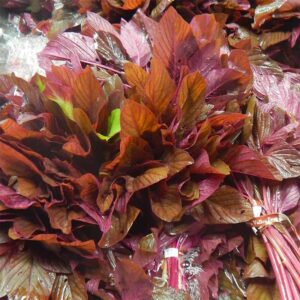What’s In The Box with Recipe Suggestions
Amaranth: This is the gorgeous pinkish-red “green” in this week’s box. Check out this week’s vegetable feature article to learn more about this Wisconsin “superfood!”
Summer Amaranth & Quinoa Salad with Chickpeas
Summer Rice and Cheese Gratin with Zucchini & Amaranth
Green Beans: Blanching is a simple process that involves briefly cooking a vegetable, such as green beans, in salted boiling water, then removing them from the water and immediately submerging them in ice water to stop the cooking process. If you want to use fresh green beans in a salad, blanch them first to retain the fresh bean flavor but tenderize them a bit. You can also freeze blanched green beans, just pat them dry and put them in a freezer bag.
Chinese “Dry-Fried” Green Beans
Broccoli: This vegetable is a powerhouse of nutrients, which is why it’s a good one to eat frequently!
Buffalo Chicken Broccoli Cheddar Bites
Broccoli Slaw with Miso Ginger Dressing
Carrots: Just give them a little scrub and you’re ready to go!
Green and/or Silver Slicer Cucumbers: Use cucumbers to make the Yogurt Cucumber Sauce to accompany this week’s featured eggplant dish.
Roasted Eggplant with Spiced Chickpeas and Tomatoes
Eggplant: You will receive one or more of three varieties including the traditional Black eggplant, the striped Listada or long and slender Lilac Bride. Refer to last week’s vegetable feature article for more information.
Burnt Eggplant with Zaatar Flatbread
Fresh Italian Garlic: Italian garlic is the variety we’ve been sending thus far. It has purple coloring on the skin and generally has smaller cloves with more cloves per bulb than the Porcelain variety.
Jalapeño Peppers: There is one jalapeño pepper in this week’s box. This is a hot pepper and may be used in any recipe calling for jalapeños or serrano peppers, although serrano peppers are usually a little hotter than jalapeños.
Roasted Tomatillo & Chickpea Curry
Scallions: Make sure you use the green tops and the white base of the onion.
Skillet Chicken and Zucchini with Charred Onion Salsa
Green Bell Pepper: Stuffed peppers are always an option, but sautéed peppers are also a flavorful addition to sandwiches, fajitas, scrambled eggs, etc.
Crock Pot Chicken Philly Cheesesteak
New Potatoes: Due to their thin skins, they won’t store for more than a week or two. Eat them soon! They are great for boiling, steaming or roasting. They have moist, waxy flesh.
Sweet Corn: We are just starting the sweet corn season. You need to keep your sweet corn cold to preserve its sweetness and we recommend eating it within a day or two for the maximum flavor.
Cheese Tortellini with Tomatoes and Corn
Tomatillos: Tomatillos are the base ingredient in the traditional salsa verde, but they can be used for more than just salsa.
Roasted Tomatillo & Chickpea Curry
Sun Orange, Chocolate Sprinkles, or Red Grape Tomatoes: Our tomatoes are just starting to ripen, so this is just a little teaser of tomato taste this week! Pop these beauties in your mouth and taste the sweet tomato flavor!
Large Tomato: Our large tomatoes are taking their sweet time ripening – it always feels like it takes forever. This week you will see one of our large variety tomatoes. Watch for more coming in the weeks ahead. Enjoy slices of fresh tomatoes sprinkled with coarse sea salt and a drizzle of olive oil.
Green and/or Italian and/or Yellow Scallopini Squash: Slice lengthwise, brush slices with oil, season and lay them on the grill just long enough to make grill marks. Roll them up and serve them with basil pesto or olive tapenade.
Vegetable Feature: Amaranth

This week’s featured vegetable is not only gorgeous, but it’s also packed with nutrition! We’re talking about Amaranth Greens! While this is a “green” type vegetable, the leaves on this beauty are actually a dark burgundy red color.
Amaranth is thought to have originated in Central and/or South America but has made its way around the globe. It can be found in Europe, Asia, and the Americas, which means there are many options for finding ways to use this vegetable. Amaranth is used in Indian cuisine, paired with a variety of lentil and curry dishes. It’s also used in the Caribbean where it’s known as callaloo and is used in soups laced with coconut and chiles. You’ll also find amaranth in Chinese cuisine, either lightly stir-fried with garlic, etc. or incorporated into a simple soup such as the one featured in this week’s newsletter! As we mentioned, amaranth is thought to have originated in Central and/or South America, so it also pairs well with flavor combinations from the cuisine of these regions. One of the reasons we choose to include amaranth in our line-up of “CSA Vegetables” is because it thrives in the heat of the summer when other greens and lettuce really struggle. As such, it goes well with all those other summer vegetables including zucchini, eggplant, peppers, potatoes, tomatoes, corn, onions and garlic.
Amaranth could be called one of our own “superfoods.” The leaves are rich in calcium, phosphorus, protein, vitamin C, carotene, iron, B vitamins, and trace elements including zinc and manganese. Compared to spinach, amaranth leaves have three times more vitamin C, calcium and niacin! Of course, we know vegetables that have rich colors like the magenta leaves of amaranth are also packed with important phytonutrients and antioxidants.

The variety of amaranth we grow is referred to as “Polish Amaranth.” We purchased the seed from Wild Garden Seeds (WGS), which is kind of funny because our own Farmer Richard is the one who actually gave them the seed originally! For those of you who haven’t heard the story, it goes like this: One day Richard was driving to LaCrosse, WI and saw this beautiful red amaranth growing in a garden along the way. He stopped and asked the people who lived there about this plant. They said their Aunt May brought the seed with her from Poland and they were happy to share it with Richard. So, Richard collected some seeds and started growing them, mostly as a baby green to mix into his gourmet salad mix. It didn’t do so well as a salad mix ingredient, but in later years we found success growing it as a mid-summer bunching green used for cooking. Since we aren’t in the business of seed production, Richard passed the seed onto Frank Morton at WGS and he has been maintaining this variety of amaranth. Thanks Frank!
While amaranth may be eaten raw, at this stage where it is more mature, we recommend enjoying it as a cooking green for optimal flavor. The stems are often tender enough to be eaten as well. The stems will need just a little extra cooking time, so I like to separate the stems and leaves. Cut off about one inch of the lower portion of the stem and then finely chop them. When cooking, add the stems to the pan a few minutes ahead of the leaves. Amaranth can be simply boiled, steamed or sautéed with garlic and onions for a super-simple preparation. You can also wilt it into soups, grain dishes, curries, and bean dishes. Many of the nutrients in amaranth, including the phytochemical that gives it its pink color, are water soluble. Thus, you’ll notice when you cook amaranth the leaves will often turn green and the cooking liquid or other ingredients you’re cooking with the amaranth will turn pink! Always try to use any cooking liquid (e.g. if you choose to simmer or boil amaranth) so you retain the nutrients. Amaranth is similar in flavor to spinach, except it’s even better!
Store amaranth greens in the refrigerator loosely wrapped in a plastic bag or a storage container with a lid. If you want to enjoy their beauty before you eat them, you can also put them in a vase and leave them at room temperature where you can see them! Be sure to change the water daily. Enjoy!
Short & Sweet Weekly Farm Update
Last Sunday morning, before it was too hot, Richard took a meditative walk through our beautiful tomato/eggplant/pepper field. With our planting maps in hand, walking through the whole 5 acres, checking each variety for size, color and amount of fruit set on. The end resulting notes were everything looked great! We are only days or a couple of weeks from a tsunami of sweet colored peppers, hot peppers and poblanos. The mini sweet pepper plants are loaded with green fruit. The Italian frying peppers will soon be ripening to the red and orange sweet peppers we all love. The eggplants are healthy plants with lots of fruit set and still blossoming.

We have all noticed an abundance of pollinators on and around the farm. There are small to large bumblebees on the blossoms of the tomatillo plants. Our melons and watermelon plants have lots of fruit set on healthy vines and new flowers being pollinated by our bee friends. Also visiting the melon field are the racoons. Those cute little bandits like to take a bite out of each melon, not just eat one whole melon then move on. This led us to put up an electric fence around the field immediately to save some melons for our CSA members to enjoy too!





